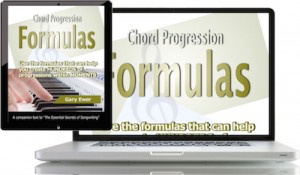Chord progressions offer an important sense of direction. It’s why they’re called progressions and not successions.
And of course, most elements within a song come with a similarly important sense of direction. Melodies and lyrics typically work in a forward direction, but when performed backwards, they don’t usually work at all.
 “Chord Progression Formulas” shows you how to create dozens of great progressions practically instantly by using some powerful formulas. Get it separately, or as part of “The Essential Secrets of Songwriting 10-eBook Bundle”
“Chord Progression Formulas” shows you how to create dozens of great progressions practically instantly by using some powerful formulas. Get it separately, or as part of “The Essential Secrets of Songwriting 10-eBook Bundle”
Paradoxically, one of the best ways to create a chord progression for your song, particularly if you’re stumped and don’t know what chord to use next, is to start at the end and work backwards. Here’s a bit more about what that means.
Most progressions have a target — a chord that feels like “home.” Normally, that chord is the tonic chord: the one that represents the key of your song. So if your song is in C major, the C chord is the tonic chord, and you’ll notice that most songs will feature that tonic chord frequently, especially in the chorus.
Not every chord progression will end on the tonic chord, but let’s say you’re having troubles getting any progression working. You might simplify your process and make an assumption that you’re going to end your new progression on C:
… ____ ____ ____ C
Once you’ve made that decision, you then start adding chords, but adding them before that final C chord. In other words, work backwards. You need to think about what chord you want to lead into the C. You’ve got several choices:
____ ____ F C
or
____ ____ Dm C
or
____ ____ G7 C
You get the idea. There are many choices out there in addition to those ones listed above: Bb-C, Am-C, and so on. But the task is to get the end of the progression working well.
So let’s say you’ve decided that you like Dm-C. Now you need to find a chord that leads properly to the Dm chord. Maybe:
____ Am Dm C
That Am works well because the root of the Am chord (A) is a 4th away from the root of the Dm chord (D). In chord progressions, adjacent chords whose roots are a 4th or 5th away from each other will practically always work.
But put your improvisation skills to work, and see what else you like:
____ Bb Dm C, or
____ F Dm C, or
____ G Dm C
…and so on.
Let’s say you really like that Bb-Dm-C progression. Now you find a chord that leads into the Bb, so keep working backwards:
F Bb Dm C, or
G Bb Dm C, or
Am Bb Dm C.
The idea here is that you’ll often wind up with a stronger progression that has a better sense of forward direction by working backwards. There’s a good reason that this procedure works so well: Since every chord in a progression acts as the target for whichever chord immediately precedes it, this method gives you the target first, and then it’s simply a matter of finding a chord that leads well to it.
 Written by Gary Ewer. Follow Gary on Twitter
Written by Gary Ewer. Follow Gary on Twitter
 If you’re ready to study — to learn why a great song succeeds — and then to apply those discoveries to your own songs, you’re ready for “The Essential Secrets of Songwriting 10-eBook Bundle.” Get today’s FREE DEAL
If you’re ready to study — to learn why a great song succeeds — and then to apply those discoveries to your own songs, you’re ready for “The Essential Secrets of Songwriting 10-eBook Bundle.” Get today’s FREE DEAL










